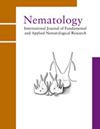来自伊朗中北部山区的Xiphinema sangesarense n.sp.(Dorylaimida:Longidoridae)的形态和分子特征为土壤线虫隐蔽物种形成提供了新证据
IF 1.2
4区 生物学
Q2 ZOOLOGY
引用次数: 0
摘要
从伊朗中北部塞姆南省牧场采集的根际土壤样本中发现了一种新的匕首线虫属Xiphinema,并根据形态学和分子数据进行了描述。sangesarense Xiphinema n.sp.的特征是3.7-4.8毫米长的雌性,有136-154μm长的齿状体,74-87μm长,两个同样发育的生殖道,子宫管状部分有结晶体,短的背部凸起,腹部微凸起的尾部,末端有一个短尖头,有四个幼年发育阶段,雄性存在,功能正常。该新物种最接近于X.azarbaijanese,被认为是其初步的隐蔽形式,但由于繁殖模式、形态和分子差异而与之分离。与第二个相似物种A.afratakhthense相比,它可以根据形态差异,特别是幼鱼的特征和分子数据进行分离。此外,该新种在形态特征(主要是子宫结构和类似的雌性尾巴)方面与已知的五个种(即:A.aequum、X.horvatovicae、X.illyricum、X.macedonicum和X.vuittenezi)有着密切的形态,并讨论了它们之间的差异。在使用两个部分大亚基(LSU)D2-D3的几个序列和内部转录间隔区(ITS)序列对新物种进行系统发育分析时,该新物种在LSU树中与Xiphinema sp.形成分支,在ITS树中与X.afratakhthense形成分支。在细胞色素c氧化酶I(COI)基因树中,新物种的序列占据了非洲X。本文章由计算机程序翻译,如有差异,请以英文原文为准。
New evidence on cryptic speciation in soil-inhabiting nematodes, with morphological and molecular characterisation of Xiphinema sangesarense n. sp. (Dorylaimida: Longidoridae) from north-central mountains of Iran
A new species of the dagger nematode, genus Xiphinema, was recovered from the rhizospheric soil samples collected from rangelands in Semnan province, north-central Iran, and described based upon both morphological and molecular data. Xiphinema sangesarense n. sp. is characterised by 3.7-4.8 mm long females having 136-154 μm long odontostyle, 74-87 μm long odontophore, two equally developed genital tracts with crystalloid bodies in the tubular part of the uterus, short dorsally convex, ventrally slightly convex tail with a mucron at the end, four juvenile developmental stages and males present, functional. The new species most closely resembles X. azarbaijanense and is regarded as its tentative cryptic form, but was separated from it by reproductive mode, and morphological and molecular differences. Compared to X. afratakhtehense, the second similar species, it could be separated based on morphological differences, especially characteristics of juveniles and molecular data. Furthermore, the new species has close morphology with five know species, namely: X. aequum, X. horvatovicae, X. illyricum, X. macedonicum and X. vuittenezi, in terms of morphological characteristics (mainly structure of uterus and similar female tail), and their differences are discussed. In phylogenetic analyses of the new species using several sequences of two partial large subunit (LSU) D2-D3, and internal transcribed spacer (ITS) sequences, the new species formed a clade with Xiphinema sp. in the LSU tree, and in the ITS tree it formed a clade with X. afratakhtehense. In the cytochrome c oxidase I (COI) gene tree, sequences of the new species occupied a placement inside the clade of several sequences of X. afratakhtehense.
求助全文
通过发布文献求助,成功后即可免费获取论文全文。
去求助
来源期刊

Nematology
生物-动物学
CiteScore
2.60
自引率
33.30%
发文量
67
审稿时长
3 months
期刊介绍:
Nematology is an international journal for the publication of all aspects of nematological research (with the exception of vertebrate parasitology), from molecular biology to field studies. Papers on nematode parasites of arthropods, and on soil free-living nematodes, and on interactions of these and other organisms, are particularly welcome. Research on fresh water and marine nematodes is also considered when the observations are of more general interest.
Nematology publishes full research papers, short communications, Forum articles (which permit an author to express a view on current or fundamental subjects), perspectives on nematology, and reviews of books and other media.
 求助内容:
求助内容: 应助结果提醒方式:
应助结果提醒方式:


